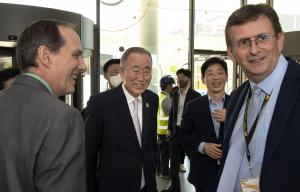Whereas Vice-Minister Oh receives regular reports on ITER, former Secretary-General Ban was new to the project's progress and challenges. As Kijung Jung, the head of the Korean Domestic Agency, guided the group through site landmarks such as the Poloidal field Coil Winding Facility, the Assembly Hall, and the Tokamak pit, Ban discovered something that was familiar to him: nations working together for a common goal. The ITER collaboration, which brings together 35 nations, is smaller that the United Nations, which comprises 193 Member States. "But what I sense here is a similar spirit," said the former Secretary-General.
Standing at the foot of the giant, Korean-built sector sub-assembly tools where ITER vacuum vessel sector "modules" are assembled, both men felt an intense pride for their country. "Of course there are issues, delays and unpredictable challenges," said Vice-Minister Oh. "This is inevitable with such a complex, multinational, one-of-a-kind venture."



